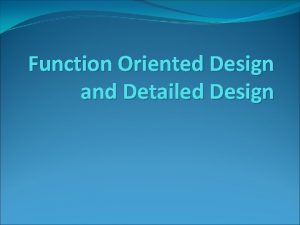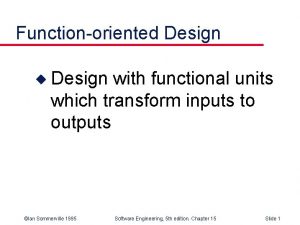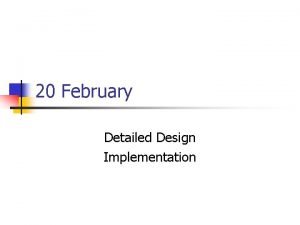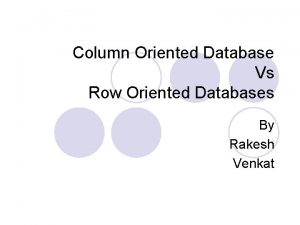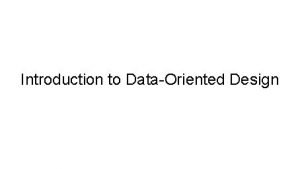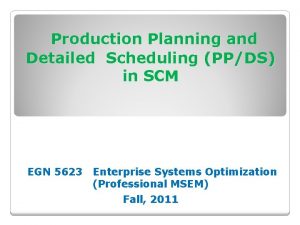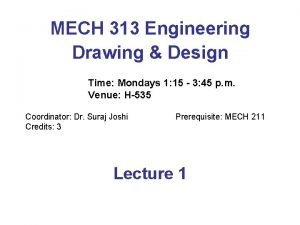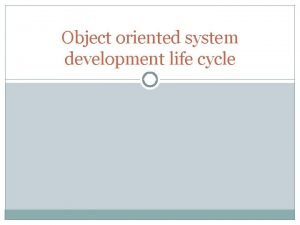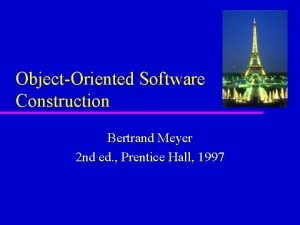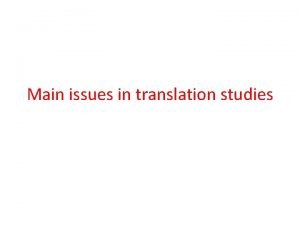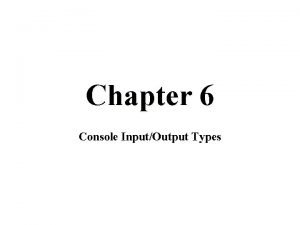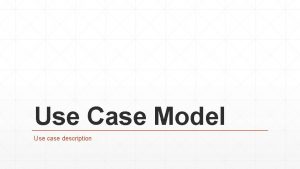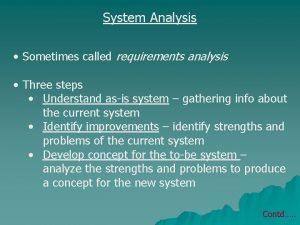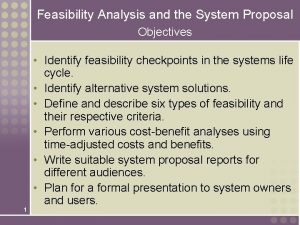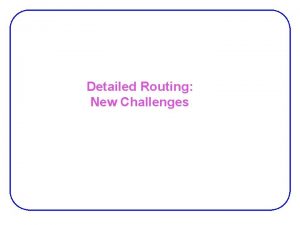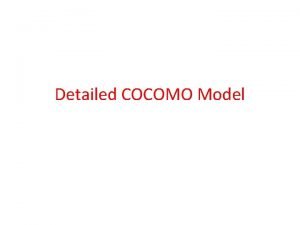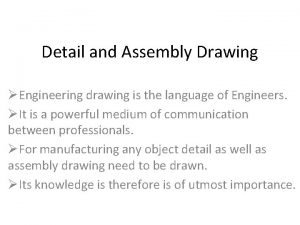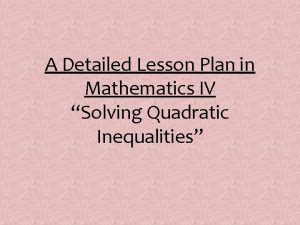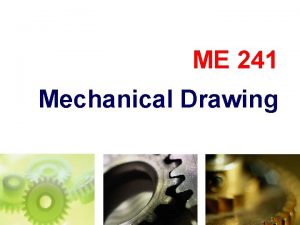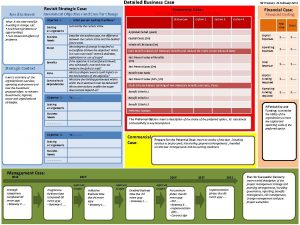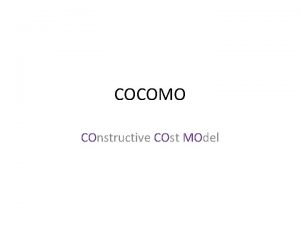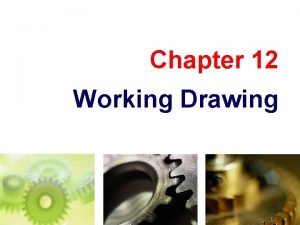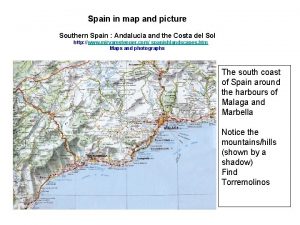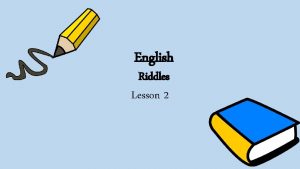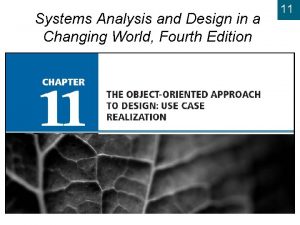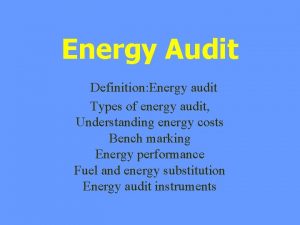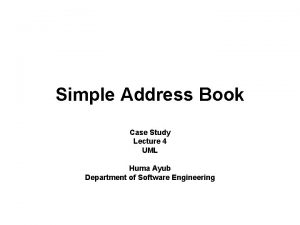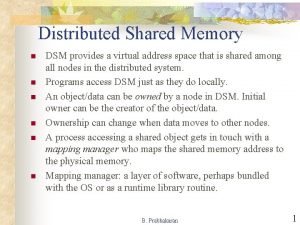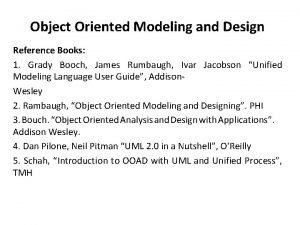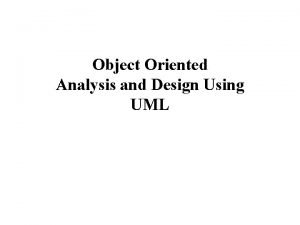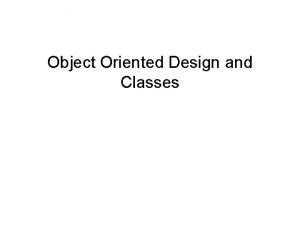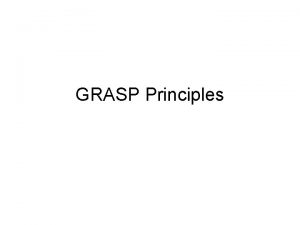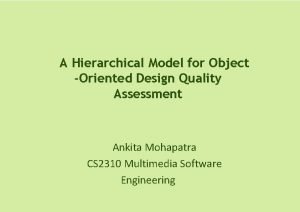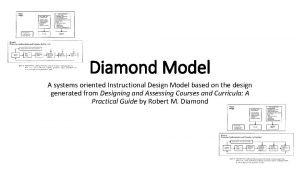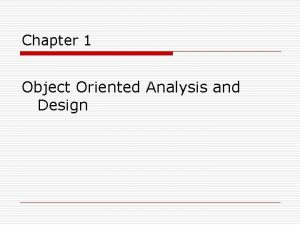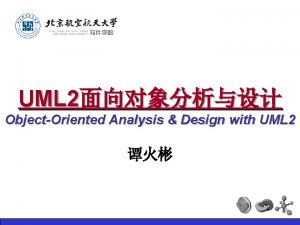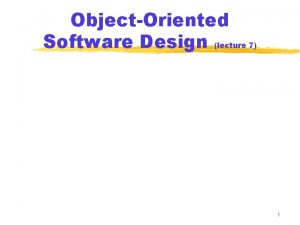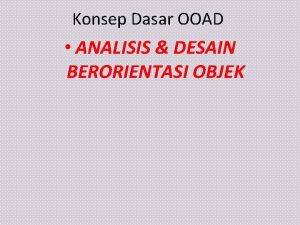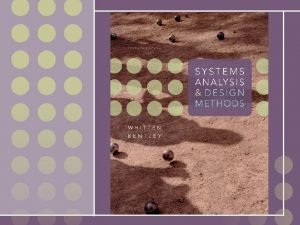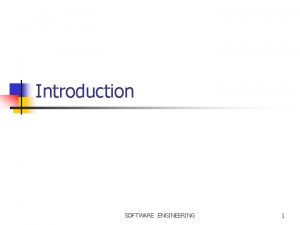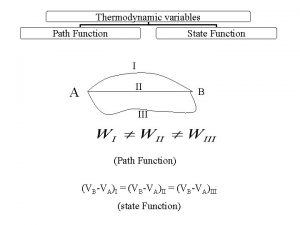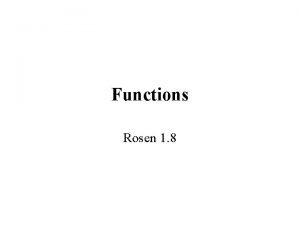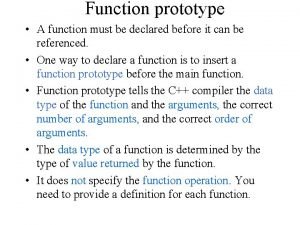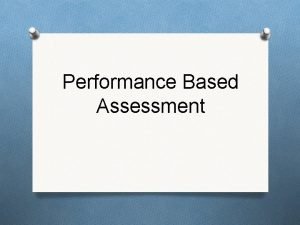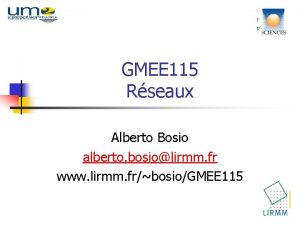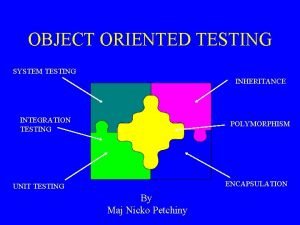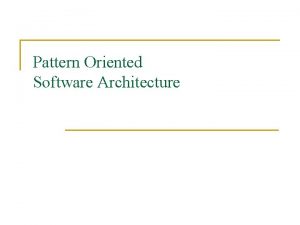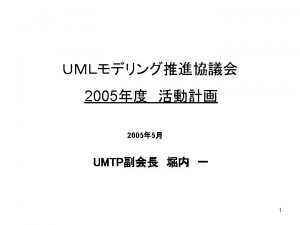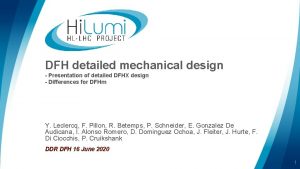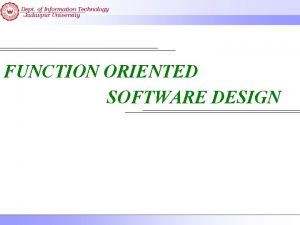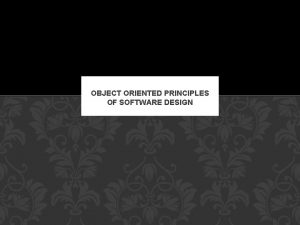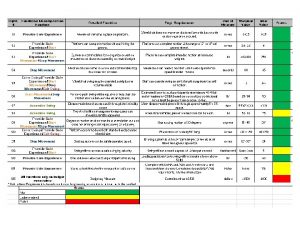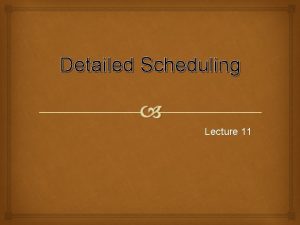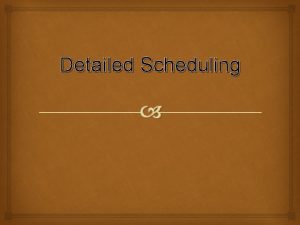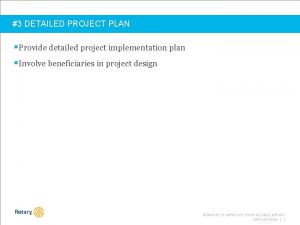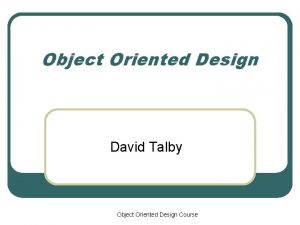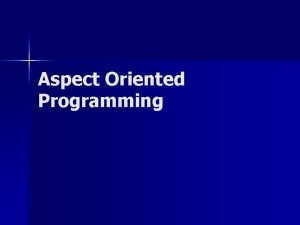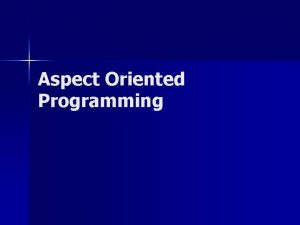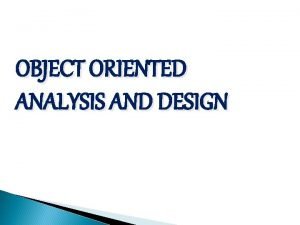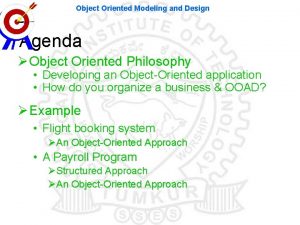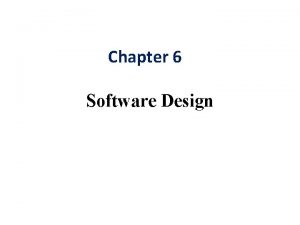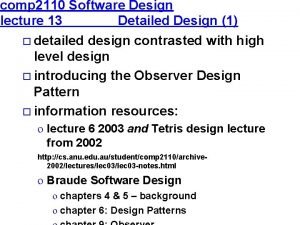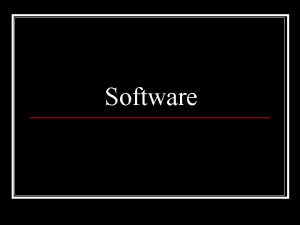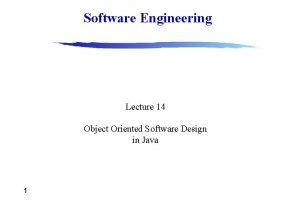Function Oriented Design and Detailed Design Software Design
















































































- Slides: 80

Function Oriented Design and Detailed Design

Software Design Noun : Represents the abstract entity -design- of a system Design of an existing system Every existing system has a design Design of a system to be constructed Design is a plan for a solution Verb : The process of design(ing), which results in a design Resulting design is a plan for a solution

Design… Design activity begins with a set of requirements Design done before the system is implemented Design is the intermediate language between requirements and code Moving from problem domain to solution domain Proceeding from abstract to more concrete representations Result is the design to be used for implementing the system

Design… Design is a creative activity Goal: to create a plan to satisfy requirements Perhaps the most critical activity during system development Design determines the major characteristics of a system Has great impact on testing and maintenance Design document forms reference for later phases

Levels in Design Process Architectural design Identifies the components needed for the system, their behavior, and relationships We have already discussed it High Level Design Really is the module view of the system I. e. what modules are in the system and how they are organized

Levels. . Logic design Components and modules are designed to satisfy their specs How to implement components Algorithms for implementing component are designed Complete design: the architectural design, the high level design, and Logic design of each component

Design Methodologies Many possibilities for design, methodologies aim to reduce search space Provide some discipline for handling complexity Most methodologies deal with high level design Provide a set of rules for guiding the designer Rules do not reduce design to a sequence of mechanical steps Many methodologies exist Diff. methodologies may be useful for diff. applications

Design Objectives Goal is to find the best possible design Have to explore different designs Evaluation criteria are often subjective and non quantifiable Major criteria to evaluate a design Correctness Efficiency Maintainability Cost

Correctness is the most fundamental Does design implement requirements? Is design feasible, given the constraints? Efficiency Concerned with the proper use of scarce resources processor & memory Other factors same, efficiency should be maximized

Maintainability Most important quality criteria Most affected by architectural design Should facilitate testing Should facilitate discovery and correction of bugs Make modifying the system easier Cost For same quality, minimize cost Design costs are quite small Should try to minimize cost in later phases

Design Principles Design is a creative process How to create a design from abstract requirements There are principles for guiding during design Two fundamental principles in the design process Problem partition Abstraction

Problem Partitioning Basic principle "divide and conquer" Divide the problem into manageably small pieces Each piece can be solved separately Each piece can be modified separately Pieces can be related to the application Pieces cannot be independent; they must communicate Communication adds complexity As number of components increases, this cost increases Stop partitioning when cost is more than benefit

Abstraction Necessary for partitioning Used in all engg disciplines (all walks of life) Abstraction of existing components Represents components as black boxes Hides the details, provide external behavior Useful for understanding existing systems Necessary for using systems Useful for determining design of existing systems

Abstraction during design process Components do not exist a priori To decide how components interact the designer specifies the external behavior of components Allows concentrating on one component at a time Permits a component to be considered without worrying about others Allows designer to control the complexity Permits gradual transition from abstract to concrete Necessary for solving parts separately

Functional Abstraction Employs parameterized subprograms Specifies the functional behavior of a module Module is treated as a input/output function Most languages provide features to support this (e. g. functions, procedures, …) A functional module can be specified using pre and post conditions

Data Abstraction An entity in the real world provides some services to the environment it belongs Similar is the case of data entities Certain operations are required from a data object The internals are not of consequence Data abstraction supports this view Data is treated as a set of pre defined operations Only operations can be performed on the objects Internals are hidden and protected Modern languages support data abstraction

Top-Down vs Bottom-up Design Top down design Starts with the system specifications Defines a module to implement the specs Specifies subordinate modules Then treats each specified module as the problem Refinement proceeds till bottom level modules reached At each stage a clear picture of design exists Most natural for handling complex problems Have been propagated by many Many design methodologies based on this Feasibility is not know till the end

Bottom up Design In we start by designing bottom modules Building blocks Layers or abstraction or virtual machines Necessary if existing modules have to be reused Pure top-down or bottom-up is not possible In bottom-up must have some idea of the top Often a combination is used

Modularity is the degree to which a system's components may be separated and recombined. A concept closely tied to abstraction Modularity supports independence of models Modules support abstraction in software Supports hierarchical structuring of programs Modularity enhances design clarity, eases implementation Reduces cost of testing, debugging and maintenance Cannot simply chop a program into modules to get modularly Need some criteria for decomposition

Coupling Independent modules: if one can function completely without the presence of other Independence between modules is desirable Modules can be modified separately Can be implemented and tested separately Programming cost decreases In a system all modules cannot be independent Modules must cooperate with each other More connections between modules More dependent they are More knowledge about one module is required to understand the other module. Coupling captures the notion of dependence

Coupling between modules is the strength of interconnections between modules In general, the more we must know about module A in order to understand module B the more closely connected is A to B "Highly coupled" modules are joined by strong interconnection "Loosely coupled" modules have weak interconnections

Goal: modules as loosely coupled as possible Where possible, have independent modules Coupling is decided during architectural design Cannot be reduced during implementation Coupling is inter-module concept Major factors influencing coupling Type of connection between modules Complexity of the interface Type of information flow between modules

The complexity and obscurity of interfaces increase coupling Minimize the number of interfaces per module Minimize the complexity of each interface Coupling is minimized if Only defined entry of a module is used by others Information is passed exclusively through parameters Coupling increases if Indirect and obscure interface are used Internals of a module are directly used Shared variables employed for communication

Coupling increases with complexity of interfaces (eg. number and complexity of parameters) Interfaces are needed to support required communication Often more than needed is used (eg. passing entire record when only a field is needed) Keep the interface of a module as simple as possible

Coupling depends on type of information flow Two kinds of information: data or control. Transfer of control information Action of module depends on the information Makes modules more difficult to understand Transfer of data information Module can be treated as input-output function

Lowest coupling: interfaces with only data communication Highest: hybrid interfaces Coupling Interface complexity Type of connection Type of Communication Low Simple, obvious to module by name data High complicated , obscure To internal elements Control or hybrid

Cohesion refers to the degree to which the elements of a module belong together. Coupling characterized the inter-module bond Reduced by minimizing relationship between elements of different modules Another method of achieving this is by maximizing relationship between elements of same module Cohesion considers this relationship Interested in determining how closely the elements of a module are related to each other In practice both are used

Cohesion of a module represents how tightly bound are the elements of the module Gives a handle about whether the different elements of a module belong together High cohesion is the goal Cohesion and coupling are interrelated Greater cohesion of modules, lower coupling between module Correlation is not perfect.

Levels of Cohesion There are many levels of cohesion. Coincidental Logical – conceptually related procedures are grouped together Temporal - aspects of a system are grouped together which are used during the same phase of execution of a program, i. e. execute close together in time Communicational - procedures that access the same data are kept together Sequential - a series of procedures, where one provides input to the next, are kept together Layer - facilities for providing or accessing a set of services through an API or hardware interface are kept together. There must also be a strict hierarchy in which higher level layers can access only lower-level layers. In other words, the system is effectively divided into layers Functional - modules which together perform a function (a computation that returns a result and has no side effects) are kept together, and everything else is kept out Coincidental is lowest, functional is highest Scale is not linear Functional is considered very strong

Determining Cohesion Describe the purpose of a module in a sentence Perform the following tests 1. If the sentence has to be a compound sentence, contains more than one verbs, the module is probably performing more than one function. Probably has sequential or communicational cohesion. 2. If the sentence contains words relating to time, like "first", "next", "after", "start" etc. , the module probably has sequential or temporal cohesion.

3. If the predicate of the sentence does not contain a single specific object following the verb, the module is probably logically cohesive. Eg "edit all data", while "edit source data" may have functional cohesion. 4. Words like "initialize", "clean-up" often imply temporal cohesion. Functionally cohesive module can always be described by a simple statement

Summary Design is a creative activity Goal is to find the best possible design Two levels in the design process Architectural design and logic design Correctness of design is most fundamental property Design principles Problem partitioning Abstraction When using functional abstraction aim for Low coupling High cohesion Design Methodologies - a set of rules/steps to guide the designer

Structured Design Methodology

Program Structure and Structure Charts Every program has a structure Structure Chart - graphic representation of structure SC represents modules and interconnections Each module is represented by a box If A invokes B, an arrow is drawn from A to B Arrows are labeled by data items Different types of modules in a SC Input, output, transform and coordinate modules A module may be a composite

SC shows the static structure, not the logic Different from flow charts Major decisions and loops can be shown Structure is decided during design Implementation does not change structure Structure effects maintainability Structured Design Methodology (SDM) aims to control the structure

SC of a Sort Program

Diff types of modules

Iteration and decision

STRUCTURED DESIGN METHODOLOGY SDM views software as a transformation function that converts given inputs to desired outputs The focus of SD is the transformation function Uses functional abstraction Goal of SDM: Specify functional modules and connections Low coupling and high cohesion is the objective Input Transformation functions Output

Main Steps in SD 1. 2. 3. 4. 5. Draw a DFD of the system Identify most abstract inputs and most abstract outputs First level factoring Factoring of input, output, transform modules Improving the structure

Data Flow Diagrams SD starts with a DFD to capture flow of data in the proposed system DFD is an important representation; provides a high level view of the system Emphasizes the flow of data through the system Ignores procedural aspects (Purpose here is different from DFDs used in requirements analysis, thought notation is the same)

Drawing a DFG Start with identifying the inputs and outputs Work your way from inputs to outputs, or vice versa If stuck, reverse direction Ask: "What transformations will convert the inputs to outputs" Never try to show control logic. If thinking about loops, if-then-else, start again Label each arrow carefully Make use of * and +, and show sufficient detail Ignore minor functions in the start For complex systems, make DGF hierarchical Never settle for the 1 st DGF

Step 2 of SD Methodology Generally a system performs a basic function Often cannot be performed on inputs directly First inputs must be converted into a suitable form Similarly for outputs - the outputs produced by main transforms need further processing Many transforms needed for processing inputs and outputs Goal of step 2 is to separate such transforms from the basic transform centers

Example 1 – counting the no of different words in a file

Step 2… Most abstract inputs: data elements in DFG that are furthest from the actual inputs, but can still be considered as incoming These are logical data items for the transformation May have little similarity with actual inputs. Often data items obtained after error checking, formatting, data validation, conversion etc.

Step 2… Travel from physical inputs towards outputs until data can no longer be considered incoming Go as far as possible, without loosing the incoming nature Similarly for most abstract outputs Represents a value judgment, but choice is often obvious Bubbles between mai and mao: central transforms These transforms perform the basic transformation With mai and mao the central transforms can concentrate on the transformation

Step 2… Problem View: Each system does some i/o and some processing In many systems the i/o processing forms the large part of the code This approach separates the different functions subsystem primarily performing input subsystem primarily performing transformations subsystem primarily performing output presentation

Example 2 – ATM

First Level Factoring First step towards a structure chart Specify a main module For each most abstract input data item, specify a subordinate input module The purpose of these input modules is to deliver to main the mai data items For each most abstract output data element, specify an output module For each central transform, specify a subordinate transform module Inputs and outputs of these transform modules are specified in the DFD

First level factoring is straight forward Main module is a coordinate module Some subordinates are responsible for delivering the logical inputs These are passed to transform modules to get them converted to logical outputs Output modules then consume them Divided the problem into three separate problems Each of the three diff. types of modules can be designed separately These modules are independent

Example 1

Example 2

Factoring Input modules The transform that produced the mai data is treated as the central transform Then repeat the process of first level factoring Input module being factored becomes the main module A subordinate input module is created for each data item coming in this new central transform A subordinate module is created for the new central transform Generally there will be no output modules

The new input modules are factored similarly Till the physical inputs are reached Factoring of the output modules is symmetrical Subordinates - a transform and output modules Usually no input modules

Example 1

Factoring Central Transforms Factoring i/o modules is straight forward if the DFD is detailed No rules for factoring the transform modules Top-down refinement process can be used Goal: determine sub-transforms that will together compose the transform Then repeat the process for newly found transforms Treat the transform as a problem in its own right Draw a data flow graph Then repeat the process of factoring Repeat this till atomic modules are reached

Example 1

Design Heuristics The above steps should not be followed blindly The structure obtained should be modified if needed Low coupling, high cohesion being the goal Design heuristics used to modify the initial design Design heuristics - A set of thumb rules that are generally useful Module Size: Indication of module complexity Carefully examine modules less than a few lines or greater than about 100 lines Fan out and fan in A high fan out is not desired, should not be increased beyond 5 or 6 Fan in should be maximized

Scope of effect of a module: the modules affected by a decision inside the module Scope of control: All subordinates of the module Good thumb rule: For each module scope of effect should be a subset of scope of control Ideally a decision should only effect immediate subordinates Moving up the decision, moving the module down can be utilized to achieve this

Transaction Analysis The above approach is transform analysis In this data flows from input to output through various transforms In transaction processing type situations, many different types of processing are done depending on type The DFD of such a system shows a bubble splitting data into many streams In execution, one of the streams is followed Transaction analysis is best for this

DFD shown in figure Note the use of + signifying OR There is a transaction center, T T takes input & then performs different transformations This can be converted to SC as shown In smaller systems, dispatching may be done in the transaction center itself

DFD for transaction analysis

Transaction analysis…

Summary Goal of design phase: produce simpler & modular design Structured design methodology is one way to create modular design It partitions the system into input subsystems, output subsystems & transform subsystems Idea: Many systems use a lot of code for handling inputs & outputs SDM separates these concerns Then each of the subsystems is factored using the DFD The design is finally documented & verified before proceeding

Detailed Design HLD does not specify module logic This is done during detailed design Process Design Logic (PDL) can also be used for detailed design of modules PDL can be used to specify the complete design architectural as well as logic design The degree of detail desired is decided by the designer One way to communicate a design: use natural language Is imprecise and can lead to misunderstanding

Other extreme is to use a formal language Such representations often have a lot of detail, necessary for implementation, but not important for communicating the design These details are often a hindrance to understanding

Ideally would like a language that is as precise as possible Does not need too much detail, target language independent can be easily converted in to an implementation This is what PDL attempts to do. PDL has outer syntax of a structure programming language Vocabulary of a natural language (English in our case) It can be thought as "structured english" Some automated processing can be done on PDL

E. g. . determine the min and max of a set of numbers in a file A design in PDL is: minmax (in file) ARRAY a DO UNTIL end of input READ an item into a ENDDO max, min: = first item of a DO FOR each item in a IF max < item THEN set max to item IF min > item THEN set min to item ENDDO END

The entire logic is described Few implementation details For implementation, the pseudo statements will have to be converted into programming language statements A design can be expressed in level of detail suitable for the problem PDL allows a successive refinement approach Encourages use of structured language constructs

The basic constructs of PDL if-then-else construct Like Pascal Conditions and the statements need not be stated formally A general CASE statement Some examples of CASE OF transaction type CASE OF operator type The DO construct: used to indicate repetition DO iteration criteria one or more statements ENDDO

The iteration criteria need not be stated formally Examples of valid use are: DO WHILE there are characters in input file DO UNTIL the end of file is reached DO FOR each item in the list EXCEPT when item is zero. A variety of data structures can be defined Eg. list, tables, scalar, records, arrays etc. All constructs should be programmable

Design Verification Main objective: does the design implement the requirements Analysis for performance, efficiency, etc may also be done If formal languages used for design representation, tools can help Design reviews remain the most common approach for verification

Metrics

Background Basic purpose to provide a quantitative evaluation of the design (so the final product can be better) Size is always a metric – after design it can be more accurately estimated Number of modules and estimated size of each is one approach Complexity is another metric of interest – will discuss a few metrics

Network Metrics Focus on structure chart; a good SC is considered as one with each module having one caller (reduces coupling) The more the SC deviates from a tree, the more impure it is Graph impurity = n – e – 1 n – nodes, e- edges in the graph Impurity of zero means tree; as this number increases, the impurity increases

Stability Metrics Stability tries to capture the impact of a change on the design Higher the stability, the better it is Stability of a module – the number of assumptions made by other modules about this module Depends on module interface, global data the module uses Are known after design

Information Flow Metrics Complexity of a module is viewed as depending on intra-module complexity Intramodule estimated by module size and the information flowing Size in LOC Inflow – info flowing in the module Outflow – info flowing out of the module Dc = size * (inflow * outflow)2

Information flow metrics… (inflow * outflow) represents total combination of inputs and outputs Its square reps interconnection between the modules Size represents the internal complexity of the module Product represents the total complexity

Identifying error-prone modules Uses avg complexity of modules and std dev to identify error prone and complex modules: Error prone: If Dc > avg complexity + std_dev Complex: If avg complexity < Dc < avg + std dev Normal: Otherwise

Metrics with detailed design When logic is known, internal complexity metrics can be determined We will cover all detailed design based metrics along with code metrics
 Function oriented design
Function oriented design Dfd ch15
Dfd ch15 Detailed design in software engineering
Detailed design in software engineering Trade-oriented sales promotion
Trade-oriented sales promotion What is a column row db
What is a column row db Data-oriented design example
Data-oriented design example Product planning and detailed scheduling
Product planning and detailed scheduling Horizontal drawing
Horizontal drawing Skimming scanning reading for detail
Skimming scanning reading for detail Object-oriented systems
Object-oriented systems Bertrand meyer object-oriented software construction
Bertrand meyer object-oriented software construction Product oriented translation
Product oriented translation Getch vs getchar
Getch vs getchar Use case model
Use case model Detailed analysis sometimes is called
Detailed analysis sometimes is called Hairdressing lesson plans
Hairdressing lesson plans The main objectives of a detailed system proposal are to
The main objectives of a detailed system proposal are to The prodigal elizabeth
The prodigal elizabeth Antenna effect in vlsi
Antenna effect in vlsi Cocomo formula
Cocomo formula Muff coupling assembly drawing
Muff coupling assembly drawing Detailed lesson plan about quadratic equation
Detailed lesson plan about quadratic equation Orthographic drawing
Orthographic drawing Heart of darkness plot
Heart of darkness plot Detailed business case
Detailed business case Suppose a project was estimated to be 400 kloc
Suppose a project was estimated to be 400 kloc Write a detailed note on unicast routing protocols
Write a detailed note on unicast routing protocols What is detail drawing
What is detail drawing Engineering drafting standards
Engineering drafting standards Southern spain map
Southern spain map Complete the riddle
Complete the riddle First cut design class diagram
First cut design class diagram Detailed comprehension
Detailed comprehension Energy audit and its types
Energy audit and its types Provide increasingly detailed data about a situation
Provide increasingly detailed data about a situation Cima work experience
Cima work experience Uml book
Uml book Range cards and sector sketches
Range cards and sector sketches Detailed lesson plan about coral reefs
Detailed lesson plan about coral reefs Show the detailed abstract view of dsm
Show the detailed abstract view of dsm Object-oriented modeling and designs books
Object-oriented modeling and designs books Object oriented analysis and design using uml
Object oriented analysis and design using uml Object-oriented systems analysis and design using uml
Object-oriented systems analysis and design using uml Object oriented analysis and design
Object oriented analysis and design Real time software design in software engineering
Real time software design in software engineering Design principles in software engineering
Design principles in software engineering Product oriented based assessment
Product oriented based assessment Object oriented design exercises
Object oriented design exercises 9 principle of grasp
9 principle of grasp Hierarchical object oriented design
Hierarchical object oriented design Robert diamond systematic design model
Robert diamond systematic design model Object oriented design uml
Object oriented design uml Object oriented design
Object oriented design Sequence diagram for tic tac toe game
Sequence diagram for tic tac toe game Ooad adalah
Ooad adalah Object oriented design axioms
Object oriented design axioms Object oriented design heuristics arthur riel pdf
Object oriented design heuristics arthur riel pdf Grasp object oriented design
Grasp object oriented design Chapter 3 skills and applications
Chapter 3 skills and applications Generic software vs custom software
Generic software vs custom software Difference between student software and industrial software
Difference between student software and industrial software Software metrics and software metrology
Software metrics and software metrology Heat capacity is state or path function
Heat capacity is state or path function Find the inverse of function f. a. b. c. d.
Find the inverse of function f. a. b. c. d. What is function prototype
What is function prototype Alert and oriented scale
Alert and oriented scale Important feature of performance based assessment
Important feature of performance based assessment Design a museum exhibit holistic rubric
Design a museum exhibit holistic rubric How to assess alert and oriented
How to assess alert and oriented Layout strategy example
Layout strategy example Loose associations
Loose associations Alert and oriented scale
Alert and oriented scale Alberto bosio
Alberto bosio Product and process oriented syllabus
Product and process oriented syllabus Process oriented syllabus
Process oriented syllabus Task-based syllabus advantages and disadvantages
Task-based syllabus advantages and disadvantages How to assess alert and oriented
How to assess alert and oriented Object oriented integration and system testing
Object oriented integration and system testing Software maintenance in software engineering ppt
Software maintenance in software engineering ppt Frank maurer
Frank maurer Improving software economics
Improving software economics
